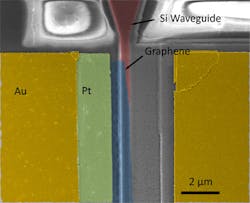Graphene optical modulators could lead to ultrafast communications
Berkeley, CA--Scientists at the University of California, Berkeley have demonstrated a new technology for graphene that could break the current speed limits in digital communications.
The team of researchers, led by UC Berkeley engineering professor Xiang Zhang, built a microscopic graphene-based optical modulator. Such devices could soon allow consumers to stream full-length, high-definition 3D movies to a smartphone in a matter of seconds, the researchers said. In this work, described in the May 8 advanced online publication of the journal Nature, the researchers were able to tune the graphene electrically to absorb light in wavelengths used in data communication.
"The impact of this technology will be far-reaching," said Feng Wang, one of the researchers. "In addition to high-speed operations, graphene-based modulators could lead to unconventional applications due to graphene's flexibility and ease in integration with different kinds of materials. Graphene can also be used to modulate new frequency ranges, such as mid-infrared light, that are widely used in molecular sensing."
"Graphene is compatible with silicon technology and is very cheap to make," said Ming Liu, post-doctoral researcher in Zhang's lab and co-lead author of the study. "Researchers in Korea last year have already produced 30 in. sheets of it. Moreover, very little graphene is required for use as a modulator. The graphite in a pencil can provide enough graphene to fabricate 1 billion optical modulators."
Manipulating the Fermi level
It is the behavior of photons and electrons in graphene that first caught the attention of the UC Berkeley researchers. The researchers found that the energy of the electrons, referred to as its Fermi level, can be easily altered depending upon the voltage applied to the material. The graphene's Fermi level in turn determines if the light is absorbed or not.
When a sufficient negative voltage is applied, electrons are drawn out of the graphene and are no longer available to absorb photons, making the graphene transparent. Graphene is also transparent at certain positive voltages because, in that situation, the electrons become packed so tightly that they cannot absorb the photons.
The researchers found a sweet spot in the middle where there is just enough voltage applied so the electrons can prevent the photons from passing, effectively switching the light off. In their experiment, the researchers layered graphene on top of a silicon waveguide to fabricate optical modulators. The researchers were able to achieve a modulation speed of 1 GHz, but they noted that the speed could theoretically reach as high as 500 GHz for a single modulator.
The researchers shrank a graphene-based optical modulator down to 25 square microns (the footprint of a typical commercial modulator can be as large as a few square millimeters). Even at such a small size, graphene packs a punch in bandwidth capability. Graphene can absorb a broad spectrum of light, ranging from ultraviolet to infrared wavelengths. This allows graphene to carry more data than current state-of-the-art modulators, which operate at a bandwidth of up to 10 nm, the researchers said.

John Wallace | Senior Technical Editor (1998-2022)
John Wallace was with Laser Focus World for nearly 25 years, retiring in late June 2022. He obtained a bachelor's degree in mechanical engineering and physics at Rutgers University and a master's in optical engineering at the University of Rochester. Before becoming an editor, John worked as an engineer at RCA, Exxon, Eastman Kodak, and GCA Corporation.
